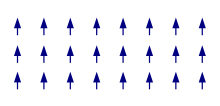- Magnetic structure
-
The term magnetic structure of a material pertains to the ordered arrangement of magnetic spins, typically within an ordered crystallographic lattice. Its study is a branch of solid-state chemistry.
Magnetic structures
Most solid materials are Pauli-paramagnetic. These materials either do not have electron spins or these spins are not ordered unless an external field induces some non-random orientation. Such materials are not considered to 'have' a magnetic structure. This is different for ferro-, ferri- and antiferromagnetic materials. They differ in the relative ordering of their spins within the lattice. In some ferromagnetic cases the structure may be relatively simple in that all spins point in the same direction, or at least that would be the case at very low temperatures. Towards higher temperatures there will be more and more 'rebellious' spins defying the order of the magnetic structure and at a certain temperature the order will break down and the spins will point in random directions. In some materials the pattern in which the spins order is much more complicated[1]. In antiferromagnetic materials spins point in opposite directions so that the overall magnetic moment is zero. However, this is not necessarily achieved by a simple up and down pattern. Much more complicated structures can arise. At times one can recognize layers in which all spins point in one direction (as in a ferromagnet) but in the next layer they point in the opposite direction giving an overall antiferromagnetic arrangement. The possible number of arrangements is very large and can include spirals, clusters, tetrahedra etc.
 A different simple antiferromagnetic arrangement in 2D
A different simple antiferromagnetic arrangement in 2D
Techniques to study them
Such ordering can be studied by observing the magnetic susceptibility as a function of temperature and/or the size of the applied magnetic field, but a truly three-dimensional picture of the arrangement of the spins is best obtained by means of neutron diffraction[2][3]. Neutrons are primarily scattered by the nuclei of the atoms in the structure. At a temperature above the ordering point of the magnetic moments, where the material behaves as a paramagnetic one, neutron diffraction will therefore give a picture of the crystallographic structure only. Below the ordering point, e.g. the Néel temperature of an antiferromagnet or the Curie-point of a ferromagnet the neutrons will also experience scattering from the magnetic moments because they themselves possess spin. The intensities of the Bragg reflections will therefore change. In fact in some cases entirely new Bragg-reflections will occur if the unit cell of the ordering is larger than that of the crystallographic structure. This is a form of superstructure formation. Thus the symmetry of the total structure may well differ from the crystallographic substructure. It needs to be described by one of the 1651 magnetic (Shubnikov) groups[4] rather than one of the non-magnetic space groups.
Although ordinary X-ray diffraction is 'blind' to the arrangement of the spins, it has become possible to use a special form of X-ray diffraction to study magnetic structure. If a wavelength is selected that is close to an absorption edge of one of elements contained in the materials the scattering becomes anomalous and this component to the scattering is (somewhat) sensitive to the non-spherical shape of the outer electrons of an atom with an unpaired spin. This means that this type of anomalous X-ray diffraction does contain information of the desired type.
References
- ^ an example
- ^ Neutron diffraction of magnetic materials / Yu. A. Izyumov, V.E. Naish, and R.P. Ozerov ; translated from Russian by Joachim Büchner. New York : Consultants Bureau, c1991.ISBN 030611030X
- ^ A demonstration by Brian Toby
- ^ p.428 Group Theoretical Methods and Applications to Molecules and Crystals. By Shoon Kyung Kim.1999. Cambridge University. Press.ISBN 0521640628
Magnetic states Categories:- Magnetic ordering
- Solid-state chemistry
Wikimedia Foundation. 2010.


